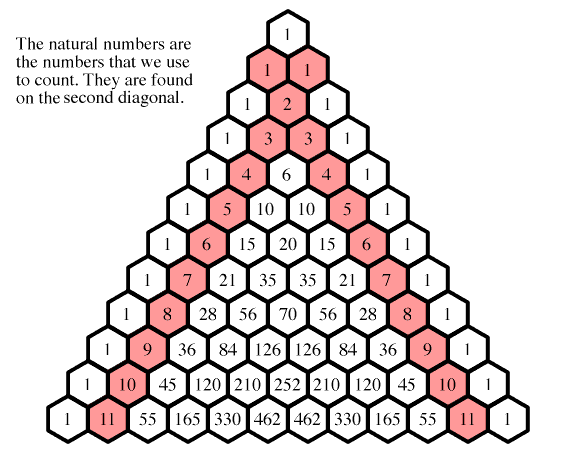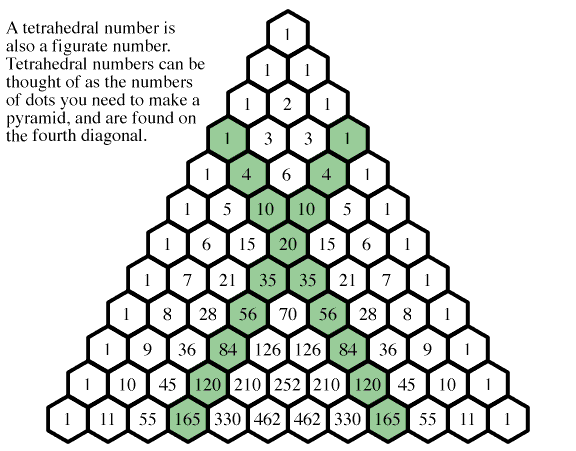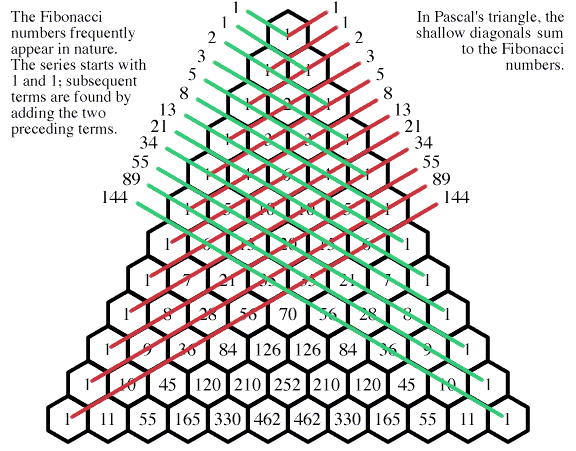
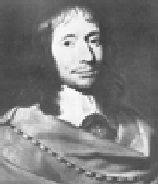


|
|
|
|
|
|
|
|
1 |
|
|
|
|
|
|
|
|
Row 0 | ||
|
|
|
|
|
|
|
1 |
|
1 |
|
|
|
|
|
|
|
Row 1 | ||
|
|
|
|
|
|
1 |
|
2 |
|
1 |
|
|
|
|
|
|
Row 2 | ||
|
|
|
|
|
1 |
3 |
3 |
|
1 |
|
|
|
|
|
Row 3 | ||||
|
|
|
|
1 |
|
4 |
|
6 |
|
4 |
|
1 |
|
|
|
|
Row 4 | ||
|
|
|
1 |
|
5 |
|
10 |
|
10 |
|
5 |
|
1 |
|
|
|
Row 5 | ||
|
|
1 |
|
6 |
|
15 |
|
20 |
|
15 |
|
6 |
|
1 |
|
|
Row 6 | ||
|
1 |
|
7 |
|
21 |
|
35 |
|
35 |
|
21 |
|
7 |
|
1 |
|
Row 7 | ||
| 1 |
|
8 |
|
28 |
|
56 |
|
70 |
|
56 |
|
28 |
|
8 |
|
1 |
Row 8 | |
|
. |
||||||||||||||||||
|
. |
||||||||||||||||||
|
. |
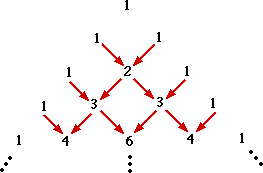
At the beginning and end of each row, where there is only one number above,
write a 1. You can think of this rule for placing the 1's as included in the first rule:
to get the first 1 in any line, you add the number above and to the left - since
there is no number there, pretend it's zero - and the number above and to the right
(1), to get a sum of 1.
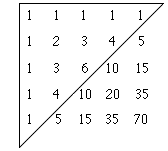
Pascal first published his ideas on the triangle in 1665. (Although
it had been known in China some centuries before this Pascal gets
the credit today.) It was constructed with each horizontal line
formed from the one above it by making each number equal to the sum
of the numbers above and to the left in the row above. For example,
the third number in the fourth line (10) equals 1 + 3 + 6.
1 1 1 1 2 1 1 3 3 1 1 4 6 4 1 1 5 10 10 5 1 1 6 15 20 15 6 1 1 7 21 35 35 21 7 1 1 8 28 56 70 56 28 8 1 1 9 36 84 126 126 84 36 9 1 1 10 45 120 210 252 210 120 45 10 1 1 11 55 165 330 462 462 330 165 55 11 1 1 12 66 220 495 792 924 792 495 220 66 12 1 1 13 78 286 715 1287 1716 1716 1287 715 286 78 13 1 1 14 91 364 1001 2002 3003 3432 3003 2002 1001 364 91 14 1 1 15 105 455 1365 3003 5005 6435 6435 5005 3003 1365 455 105 15 1 1 16 120 560 1820 4368 8008 11440 12870 11440 8008 4368 1820 560 120 16 1 1 17 136 680 2380 6188 12376 19448 24310 24310 19448 12376 6188 2380 680 136 17 1 1 18 153 816 3060 8568 18564 31824 43758 48620 43758 31824 18564 8568 3060 816 153 18 1 1 19 171 969 3876 11628 27132 50388 75582 92378 92378 75582 50388 27132 11628 3876 969 171 19 1
